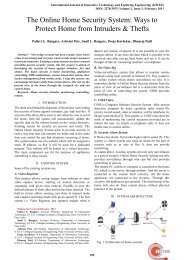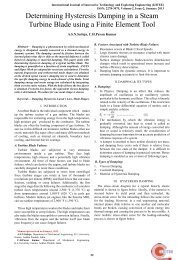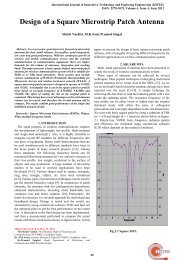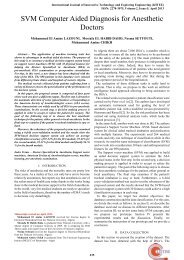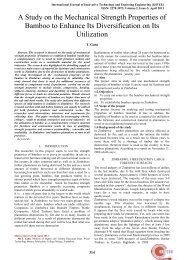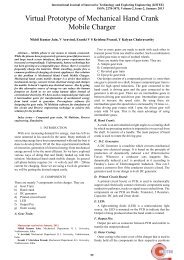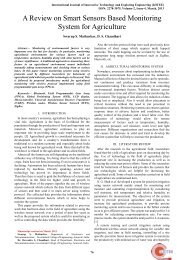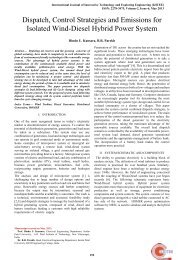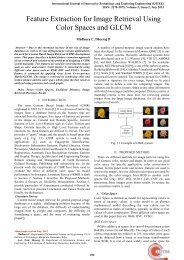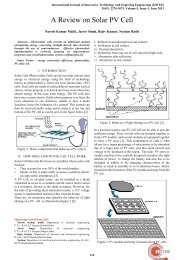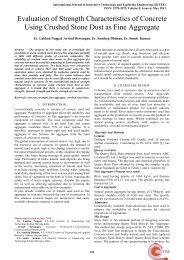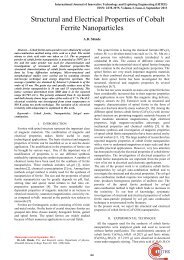Effect of Pressure Angle on Transmission Efficiency of Helical Gears
Effect of Pressure Angle on Transmission Efficiency of Helical Gears
Effect of Pressure Angle on Transmission Efficiency of Helical Gears
Create successful ePaper yourself
Turn your PDF publications into a flip-book with our unique Google optimized e-Paper software.
<strong>Efficiency</strong><br />
Internati<strong>on</strong>al Journal <str<strong>on</strong>g>of</str<strong>on</strong>g> Innovative Technology and Exploring Engineering (IJITEE)<br />
ISSN: 2278-3075, Volume-3, Issue-2, July 2013<br />
100<br />
80 90<br />
Load Dependant<br />
Losses<br />
25 22.5 20<br />
<str<strong>on</strong>g>Pressure</str<strong>on</strong>g> <str<strong>on</strong>g>Angle</str<strong>on</strong>g><br />
Fig. 10 <str<strong>on</strong>g>Pressure</str<strong>on</strong>g> angle vs. <strong>Efficiency</strong> Helix angle – 15, Speed<br />
4400 rpm<br />
All the above graphs show a significant loss in efficiency<br />
as pressure angle decreases. This means that higher the<br />
pressure angle, higher the efficiency and lower the pressure<br />
angle, lower the efficiency. But as the pressure angle<br />
increases the tooth thickness decreases. Therefore high<br />
pressure angles can be used for moderately low torques and<br />
for heavy torques low pressure angle can be used.<br />
VII. CONCLUSION<br />
An experimental test matrix, which included different<br />
pressure angles and helix angles was defined and<br />
implemented for dip lubricated c<strong>on</strong>diti<strong>on</strong>s. These results<br />
comprised the database <str<strong>on</strong>g>of</str<strong>on</strong>g> helical gearbox and gear mesh<br />
power losses and efficiency. The effects <str<strong>on</strong>g>of</str<strong>on</strong>g> pressure angle as<br />
well as the effects <str<strong>on</strong>g>of</str<strong>on</strong>g> speed and torque <strong>on</strong> the gearbox<br />
mechanical power losses and gearbox mechanical efficiency<br />
were presented graphically and quantified. The study revealed<br />
nearly the same results as that <str<strong>on</strong>g>of</str<strong>on</strong>g> the previous study for heavy<br />
vehicles. The pressure angle and torque have the significant<br />
effect <strong>on</strong> helical gear power losses. As the pressure angle<br />
increases, the power losses get reduced because <str<strong>on</strong>g>of</str<strong>on</strong>g> the fact<br />
that as the pressure angle increases the tooth thickness<br />
decreases. As the torque increases the power losses also<br />
increases. An expected increase in metal-to-metal c<strong>on</strong>tact<br />
activity with increased torque can be pointed to <strong>on</strong>e <str<strong>on</strong>g>of</str<strong>on</strong>g> the<br />
reas<strong>on</strong>s for this. It is seen from the study that efficiency<br />
increases almost linearly with speed. This improvement in<br />
efficiency can be attributed directly to the fact that the<br />
asperity interacti<strong>on</strong>s are reduced with increased speed since<br />
the lubricant film thickness is increased.<br />
NOMENCLATURE<br />
Abbrevia<br />
ti<strong>on</strong>s<br />
ΔL(τ)<br />
FF(τ)<br />
TT(τ)<br />
ΔL(τ)<br />
z<br />
b<br />
mn<br />
p<br />
aw<br />
Φ<br />
Ψ<br />
da<br />
df<br />
dw<br />
Number <str<strong>on</strong>g>of</str<strong>on</strong>g> teeth Pini<strong>on</strong> / Gear<br />
Face width (Pini<strong>on</strong> / Gear)<br />
Normal module<br />
Circular pitch<br />
Center distance (working)<br />
<str<strong>on</strong>g>Pressure</str<strong>on</strong>g> angle<br />
Helix angle<br />
Tip diameter<br />
Root diameter<br />
Operating pitch diameter<br />
2.5<br />
5<br />
7.5<br />
VIII. ACKNOWLEDGMENT<br />
It gives me an immense pleasure to express my sincere and<br />
heartiest gratitude towards my guide. Pr<str<strong>on</strong>g>of</str<strong>on</strong>g>. Dr. Y. R. Kharde<br />
for his guidance, encouragement, moral support and affecti<strong>on</strong><br />
through the course <str<strong>on</strong>g>of</str<strong>on</strong>g> my work. He has proven to be an<br />
excellent mentor and teacher. I am especially appreciative to<br />
his willingness to listen and guide me to find the best soluti<strong>on</strong>,<br />
regardless <str<strong>on</strong>g>of</str<strong>on</strong>g> challenge.<br />
I am thankful to Pr<str<strong>on</strong>g>of</str<strong>on</strong>g>. Dhumal V. B., Principal, Pr<str<strong>on</strong>g>of</str<strong>on</strong>g>.<br />
Ingole M. W., Head <str<strong>on</strong>g>of</str<strong>on</strong>g> Mechanical Department, Amrutvahini<br />
polytechnic, Sangamner, for allowing me to c<strong>on</strong>duct this<br />
work.<br />
I am also thankful to Mr. Shriram Tatwawadi, Proprietor<br />
<str<strong>on</strong>g>of</str<strong>on</strong>g> Electr<strong>on</strong>ic Switches, K-8 MIDC, Ambad, Nasik for<br />
allowing me to use his set up <str<strong>on</strong>g>of</str<strong>on</strong>g> VFD and Torque Sensor.<br />
I am also thankful to all my friends and colleagues for their<br />
guidance and support.<br />
This work is also the outcome <str<strong>on</strong>g>of</str<strong>on</strong>g> the blessings, guidance<br />
and support <str<strong>on</strong>g>of</str<strong>on</strong>g> my parents and family members.<br />
Lastly, my cordial thanks to all who have c<strong>on</strong>tributed<br />
intellectually and materially in words and deeds for<br />
completi<strong>on</strong> <str<strong>on</strong>g>of</str<strong>on</strong>g> this work.<br />
REFERENCES<br />
[1] Robert F. Handschuh and Andrew J. Zakrajsek, , ―High <str<strong>on</strong>g>Pressure</str<strong>on</strong>g><br />
<str<strong>on</strong>g>Angle</str<strong>on</strong>g> <strong>Gears</strong>: Preliminary Testing Results,‖<br />
NASA/TM—2010-216251, Internati<strong>on</strong>al Design Engineering<br />
Technical C<strong>on</strong>ferences and Computers and Informati<strong>on</strong> in<br />
Engineering C<strong>on</strong>ference, 2010,pp.17-29.<br />
[2] Michlin, Y., Myunster, V., ―Determinati<strong>on</strong> <str<strong>on</strong>g>of</str<strong>on</strong>g> Power Losses in Gear<br />
Transmissi<strong>on</strong>s with Rolling and Sliding Fricti<strong>on</strong> incorporated,‖<br />
Mechanism and Machine Theory, 37, 2002, pp.167-174.<br />
[3] Xu, H., Kahraman, A., Anders<strong>on</strong>, N.E. and Maddock, D. ―Predicti<strong>on</strong><br />
<str<strong>on</strong>g>of</str<strong>on</strong>g> Mechanical <strong>Efficiency</strong> <str<strong>on</strong>g>of</str<strong>on</strong>g> Parallel Axis Gear Pairs,‖ Journal <str<strong>on</strong>g>of</str<strong>on</strong>g><br />
Mechanical Design, 129, 2007, pp.58-68.<br />
[4] S. Li, A. Vaidyanathan, J. Harianto and A. Kahraman, ―Influence <str<strong>on</strong>g>of</str<strong>on</strong>g><br />
Design Parameters and Micro-geometry <strong>on</strong> Mechanical Power Losses<br />
<str<strong>on</strong>g>of</str<strong>on</strong>g> <strong>Helical</strong> Gear pairs,‖ JSME Internati<strong>on</strong>al C<strong>on</strong>ference <strong>on</strong> Moti<strong>on</strong> and<br />
Power Transmissi<strong>on</strong>s, Sendai, Japan, vol-3, No.-2, 2009, pp.146-158.<br />
[5] Seetharaman and Kahraman, 2009, ―Load-Independent Spin Power<br />
Losses <str<strong>on</strong>g>of</str<strong>on</strong>g> a Spur Gear Pair: Model Formulati<strong>on</strong>,‖ ASME Journal <str<strong>on</strong>g>of</str<strong>on</strong>g><br />
Tribology, 131, 2009, 022201,pp.01-11.<br />
[6] Shanming Luo and Anhua Chen ―C<strong>on</strong>straint analysis <str<strong>on</strong>g>of</str<strong>on</strong>g> pressure angle<br />
<str<strong>on</strong>g>of</str<strong>on</strong>g> involute elliptical gears‖ 12th IFToMM World C<strong>on</strong>gress, Besanç<strong>on</strong><br />
(France), June 18-21, 2007. Pp.54-63<br />
[7] Changenet, C., and Velex, P., ―A Model for the Predicti<strong>on</strong> <str<strong>on</strong>g>of</str<strong>on</strong>g><br />
Churning Losses in Geared Transmissi<strong>on</strong>s – Preliminary Results―,<br />
ASME Journal <str<strong>on</strong>g>of</str<strong>on</strong>g> Mechanical Design, 129(1), 2007,pp.128-133.<br />
[8] Heingartner, P., and Mba, D., ―Determining Power Losses in the<br />
<strong>Helical</strong> Gear Mesh,‖ Proceedings <str<strong>on</strong>g>of</str<strong>on</strong>g> the 2003 ASME Design<br />
Engineering Technical C<strong>on</strong>ferences ad Computers and Informati<strong>on</strong> in<br />
Engineering C<strong>on</strong>ference.2003,pp.127-141<br />
[9] Petry-Johns<strong>on</strong>, T., Kahraman, A., Anders<strong>on</strong>, N. E., and Chase, D. R.,<br />
―An Experimental Investigati<strong>on</strong> <str<strong>on</strong>g>of</str<strong>on</strong>g> Spur Gear <strong>Efficiency</strong>,‖ ASME<br />
Journal Machine Design, 130, 2008, 062601,pp.01-10<br />
46



